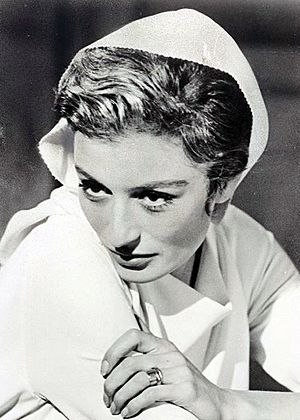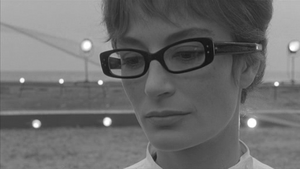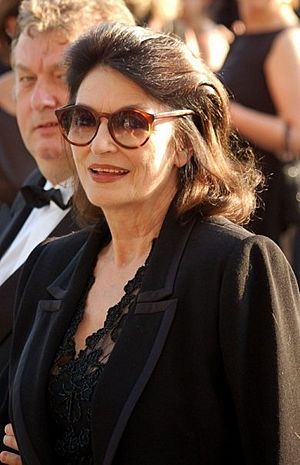Anouk Aimée facts for kids
Anouk Aimée (born Nicole Françoise Florence Dreyfus, April 27, 1932 – June 18, 2024) was a famous French actress. She starred in about 70 movies from 1947 to 2019. She started acting when she was just 14 years old. Besides going to school, she also learned acting and dance. Most of her films were French, but she also worked in Spain, Great Britain, Italy, Germany, and even some American movies.
Some of her most well-known films include La Dolce Vita (1960) and 8½ (1963) by Federico Fellini. She also starred in Lola (1961) and Justine (1969).
Anouk Aimée became internationally famous for her role in A Man and a Woman (1966). For this movie, she won the Golden Globe Award for Best Actress - Motion Picture Drama and the BAFTA Award for Best Actress. She was also nominated for an Academy Award for Best Actress. This film helped bring romantic movies back into style.
She won the Award for Best Actress at the Cannes Film Festival for her film A Leap in the Dark (1980). In 2002, she received an honorary César Award, which is France's top film award. Aimée was known for her striking looks and beauty. She often played strong, mysterious women with a touch of sadness. In the 1960s, Life magazine said her "enigmatic beauty lingered" in people's minds after her movies.
Early Life and Education
Anouk Aimée was born in Paris, France. Her father, Henri Murray, and her mother, Geneviève Sorya, were both actors. Her father was Jewish, and her mother was Catholic. Anouk was raised Catholic but later became Jewish as an adult.
She went to several schools in Paris and also studied dance at the Marseille Opera. During World War II, she attended Mayfield School, Mayfield in England. After the war, she continued to study acting and dance with a teacher named Andrée Bauer-Thérond.
Acting Career Highlights
Anouk Aimée, whose real name was Françoise Dreyfus, started her film career at age 14. Her first role was Anouk in the movie La Maison sous la mer (1946). She liked the name so much that she decided to keep it. Later, a writer named Jacques Prévert suggested she use the last name Aimée, which means "beloved" in French. He thought it would connect her to the strong emotions of her movie roles.
She starred in many important films, including The Crimson Curtain (1953) and La Dolce Vita (1960). She also appeared in 8½ (1963) and Lola (1961). People often described her as "regal," "intelligent," and "enigmatic," meaning she had a mysterious and beautiful presence on screen.
Because of her beautiful features, she was sometimes compared to Jacqueline Kennedy. Film experts have said that Anouk Aimée often played characters who were sensitive, fragile, and sometimes faced sad situations or hidden pain. Her acting skills and expressive face helped her become very successful early in her career.
Anouk Aimée gained worldwide attention with Federico Fellini's La Dolce Vita (1960) and Lola (1961). She stayed in Italy for a few years in the 1960s, making movies for different Italian directors. One writer said that after La Dolce Vita, Anouk Aimée became a "rising star who exploded" into the film world. The singer-songwriter Patti Smith even looked up to her and dreamed of being an actress like her.
Her biggest success was the film A Man and a Woman (1966), directed by Claude Lelouch. The great acting by Anouk Aimée and Jean-Louis Trintignant, along with the beautiful music, made the film a huge international hit. It won the top prize at the Cannes Film Festival in 1966 and two Oscars. In this movie, Anouk Aimée played a woman who was careful about love but then found a new romance. She created a new kind of strong, appealing female character.
Film historian Jurgen Muller noted that Anouk Aimée often brought a "melancholy aura" to her roles. In many of her later films, she continued to play sensitive women whose feelings were often kept secret.
She also starred in the American film Justine (1969) with Dirk Bogarde. A photographer named Eve Arnold once talked to Anouk Aimée about her role as Justine, who was also Jewish. Anouk shared some powerful quotes that meant a lot to her, especially about hope and strength during difficult times.
In the 1980s, the famous actor Dustin Hoffman wanted to work with Anouk Aimée on a film called La Brava. He was looking for a talented older actress and was very impressed when he met her in Paris. He told his producer how great she looked and sounded.
Another director, Robert Altman, wanted Anouk Aimée for a film about a woman who survived the Holocaust. She liked the script, but she found Altman's personality very strong and decided not to make the film with him.
In 2002, she received an honorary César Award, which is a special award for her lifetime achievements in French cinema. In 2003, she received an Honorary Golden Bear at the Berlin International Film Festival. Life magazine once called her "the Left Bank's most beautiful resident."
In 2013, the Cinemania film festival in Montreal, Canada, celebrated Anouk Aimée's long career. Her final film, The Best Years of a Life (2019), reunited her with director Claude Lelouch and co-star Jean-Louis Trintignant. This movie was a follow-up to her famous film A Man and a Woman.
Personal Life
Anouk Aimée was married and divorced four times. Her husbands were Édouard Zimmermann (1949–1950), director Nico Papatakis (1951–1954), actor and musical producer Pierre Barouh (1966–1969), and actor Albert Finney (1970–1978). She had one daughter, Manuela Papatakis, born in 1951, from her second marriage.
Images for kids
See also
 In Spanish: Anouk Aimée para niños
In Spanish: Anouk Aimée para niños







